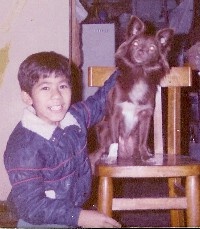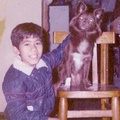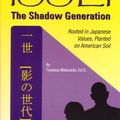It is difficult to remember exactly what it was like to be Japanese in Peru. My ethnicity mattered a lot, and at the same time, it feels like it did not. While this may be contradicting, I do not see it as logically problematic. I have taught many classes on race, ethnicity and racism, and it is always amazing to hear students of color talk about the absence of racism in their experiences growing up. However, as these courses progress, the same students become aware that racism did (and does) exist in their lives, but that they simply had not been able to identify it. Thus, in Peru, I was too young to fully understand the effect that my ethnicity had on my experience growing up. It is only in retrospect that I can begin to understand how important this factor was.
I come from an Okinawan family. My brothers and I are Peruvian Sansei. The three of us are full-blooded Japanese. My grandparents and great grandparents all came to Peru in the early 19th century when most Japanese migrants came to Peru to work in the agricultural sector. With time, like many other Japanese, we were able to establish a small business. Our small business was a restaurant in Lince, and our house was right next to the restaurant, so Lince was also our hometown. Most of the people who lived in Lince were poor, and in comparison to them, our family was economically well off. However, this is not because we had an abundance of wealth, but rather, it was because the people in the neighborhood were so underprivileged. My family worked incredibly hard just to be able to keep what we had. This situation is not too different than that of many Japanese folks in Peru. The Japanese community in Peru has become a notable middleman minority. Japanese people were known for establishing small independent businesses, and as a result they were able to become part of Peru’s small middle class. Most Japanese in Peru were not as economically deprived as the majority of the population. However, this does not mean that life was easy for us; it only means that life was incredibly difficult for most Peruvians.
To a certain degree, growing up Japanese in Peru meant having a double identity. This was apparent in our names. My brothers, uncles, aunts and I have Spanish names on our birth certificates. Thus, at birth, I was named Julio Martin Tsuha Nakazone. However, my family and close friends called me Shigueru. This was my “home” name. In fact, I cannot remember anyone addressing me as Julio at all. At home, everyone called me Shigueru, and so did my neighborhood friends with whom I used to play street soccer with. At school, everyone was called by their last name, so my friends and teachers addressed me as Tsuha. It was not until I moved to the United States at the age of 11 that people started calling me Julio. I remember thinking in Peru, that Julio as a name was wasteful because nobody called me that. To me, Julio was a person I never knew. It sounded alien to me. If I heard the name called out in public, I would have never turned to see if someone was calling me. I guess the name just did not sound familiar to me. I imagine that my brothers had similar experiences.
In order to understand how this process of naming takes place within my family, we must first understand the experience of racism that the Japanese encountered in Peru. First, the Japanese entered Peru as cheap, exploitable labor. Such oppression can be compared to that of other indentured and contract laborers in the Americas. Today, many Asian workers are brought to work in sweatshops in the United States. They are promised the opportunity to work off the price of coming to this country. They are contract laborers, but it is not uncommon that these workers are held in slave-like conditions in which they can never fully pay off their debts because the wages they receive are extremely low. The Japanese were in similar conditions. Their entry into Peru as cheap labor marked them as second-class citizens.
During World War II, the Japanese population in Peru came under attack as racist hysteria swept the Western hemisphere. This racism exploded in the form of a riot in 1940 in which Japanese businesses were attacked and ransacked. In addition, 1700 Japanese Peruvians were extradited to the United States to be put into concentration camps at the will of the U.S. government. The Peruvian government was more than happy to comply with this attack on human rights.
Being aware of the racist mobilization that could be jump-started against their population, many Japanese parents gave their kids Spanish names in an effort to have them be accepted and integrated into Peruvian society. At the same time, many of these children were called by their unofficial (yet true) Japanese name at home. This was an attempt to retain some of the Japanese culture and heritage that was considered so valuable. This calls into question the way in which we understand assimilation. Assimilation is usually thought of as a process by which immigrants begin to adopt the norms, language, religion, and general culture of the host society. Usually, the immigrants who are willing to assimilate are seen as “good” immigrants. This point of view denies migrants the right to protect their history and values as important parts of what makes up their identity. Ethnocide (cultural genocide) of migrant cultures becomes the ultimate goal of a host society. The naming process of many Japanese children then shows that simultaneously, Japanese Peruvian families actively work to maintain and celebrate their culture while strategically maneuvering through a racist regime in order to survive as a culture and a community. It would not be difficult to find similar examples of other oppressed migrant communities all around the world.
The way in which my family maintained their Japanese cultural heritage through creative naming processes was also coupled with participation in Japanese Peruvian communities. My family was part of AELU (Asociacion Estadio La Union), which was a sort of athletic/country club for the Japanese colonia1. It was here that the Japanese community would come together to play in different sports tournaments including soccer, volleyball, baseball and more. Since in Lince there were not many Japanese Peruvians, it was in AELU that we were able to interact with Japanese folks and have a space of our own. Other forms in which the community manifested itself was through the organizing of tanomoshi (organizations of people who share the same interests, skills, or profession).
These spaces were nice to have because as far as I can remember, in our town of Lince, there were not too many Japanese people outside of our family. Both in school and in our neighborhood most of my friends were Peruvians. When I look back at the most fun moments that took place in my life in Peru (outside of those spent with my family) I was surrounded by these friends. As I mentioned, most of what we did was play in the streets. Our activities were composed of mainly soccer, and then a bunch of little games that we made up with the imagination that only deprived children without toys can have. Our toys were made up of things such as bottle caps, banana peels, chalks, and sometimes small animals we used for our amusement against their will. But most of the time, all we ever needed was a ball and four rocks with which to make two goals to play soccer with.
In this setting, it is very difficult for me to deconstruct the roles that race, racism and ethnicity played in shaping the interaction of our group of friends as children. One thing was for sure. We were not color blind. Race stood out. Much like anywhere else, the socio-economic structure of Peru is highly constructed around color lines. At the very bottom, we might say that the indigenous population is situated, above them, we find the mestizos, and on the top a white minority (about 15%). Asians, Blacks and others made up about 3% of the entire Peruvian population. Just how color conscious we were stood out by the fact that these stigmatizing racial traits were often used as forms of insults between both kids and adults. However, these terms were not just that. They can be seen as terms of intimacy and not necessarily derogatory ones. Of course, this all depends on the persons using these terms, the context in which they use them, and of course, the way in which they use these words. For example, we had a friend whom we called “Cholo.” In Peru, this word is used for the indigenous folks. We used this term carelessly it seemed. This was his nickname, and we hardly ever used his real name of Roberto. I cannot quite remember enough about this to say whether the use of this word was derogatory or not. I do remember that this did not really mean much to me, and that when I said it, nothing was meant by it. I am not negating the fact that there might have been a lot of racism behind the use of the word, but I am only recalling what the word meant and signified to me when I used it towards my friend Roberto.
At the same time, I remember that people used to call us “Chinos.” Of course, this was completely wrong, since we were Japanese. And I remember that this word was invoked in both ways, that could be both an intimate expression and a racist one. If we were arguing with people, the use of this word would infuriate and hurt us as Japanese people. However, in intimate settings, even at times, Japanese people themselves would call each other “Chino.” This all just makes apparent that Peru is very far from being a color-blind society (not that this is something I consider to be good, or a goal to be reached). These forms of racial name-calling maintained ethnic boundaries and emphasized them in the course of social interaction between folks. I remember being furious when other kids would sing the jingle: “Chino, Japones, te apestan los pies” – which meant: “Chinese, Japanese, your feet stink.” This was a very common thing that was done to Asian children in Peru. But regardless of these moments of division and racism, as far as I can remember, race did not seem to play that great of a role in the way in which we chose whom to be friends with in our neighborhood2. In fact, there are times that I look back at my time spent in Peru, and I feel that I was better friends with my Peruvian buddies, and that I related to them more than my Japanese friends. I am not exactly sure why this was that way though.
When I left Peru in 1992, Alberto Fujimori was president. He was the first Asian president in any Latin American country. I remember that when he ran as a candidate for the presidency of 1990, I really wanted him to win. There was no other reason for my support for him other than the fact that he was of Japanese descent. At the age of nine, I did not really have the political consciousness to make a wise decision in presidential election politics. What I do remember is that one day I asked my parents if they were going to vote for Fujimori, and if they wanted him to win. I was surprised at their response. They said that they did not want Fujimori to win; they were not going to vote for him, and that they were really afraid of his winning the presidency. When I asked them why, they said that they were worried of what would happen if Fujimori failed as a president, and if he ruined the already failing economy of the country. This took me completely by surprise. I had never thought of that. I had never learned of the race riot of 1940, the extradition of 1,700 Japanese Peruvians to be put into concentration camps, or the exploitation of cheap, migrant, Japanese labor of the early 1900s. All I knew back then was that we came from a country that was economically prosperous, and that people were amazed by and admired Japan. This was a wake up call. Then I wondered if I really should have been afraid.
So how did I feel back then? Did I feel Japanese? Or Peruvian? I felt both ways. I felt Peruvian because (is it not obvious?) I spoke Spanish; I had never been to Japan; I was Catholic; I knew and sang the Peruvian national anthem like everybody else; I loved Peruvian food; should I go on? But I also felt proud to be Japanese3. I loved Japanese food; I felt proud to be from a prosperous country; and Japanese culture was still very apparent in our daily life. Did I feel one way more than the other? I am not sure. There was this day I remember that Peru’s and Japan’s national teams were having a sports match against each other. I do not quite remember if it was soccer or volleyball. But I do remember that I wanted Peru to win. And if my memory serves me right, it seemed to me that most of my family wanted Peru to win, except for my grandfather. I guess that means that I probably felt more of an allegiance to Peru than to Japan back then. One thing is for sure. I love that country, and I want to go back (I have not been back since 1994). I feel like I have lost much of my Peruvian culture by being in the U.S., and I would love to get some of that back. I feel disconnected in some ways and yearn to fix that. At the same time, I am afraid of going back and learning that I cannot completely do that (which may very well be the case). I am hoping to go back next year. I cannot wait.
This paper is just a recollection of what I feel is important to discuss regarding my ethnic identity in Peru. It is not an accusation of Peru as a racist country. It would not make sense for me to make such an argument without having looked at other countries. In fact, it would be very easy for me to make the case that the U.S. or Japan are even more racist than Peru. But this is not what I am trying to do. What I am trying to do is illustrate how racism exists and shapes the ethnic identity of people by providing my history as an example. At the same time, I am trying to show how you can love a country that many have tried to force you to believe is not yours. I hope you can relate.
Notes:
1. The Japanese enclaves in Peru are referred to as “colonies.”
2. This is not to say that my memory is working much like the way many of my students’ of colors memories worked as I mentioned in my opening paragraph.
3. At the time, my Okinawan heritage did not hold any primacy in my identity – the reason for this is something I am still trying to figure out.
© 2007 Shigueru Julio Tsuha





